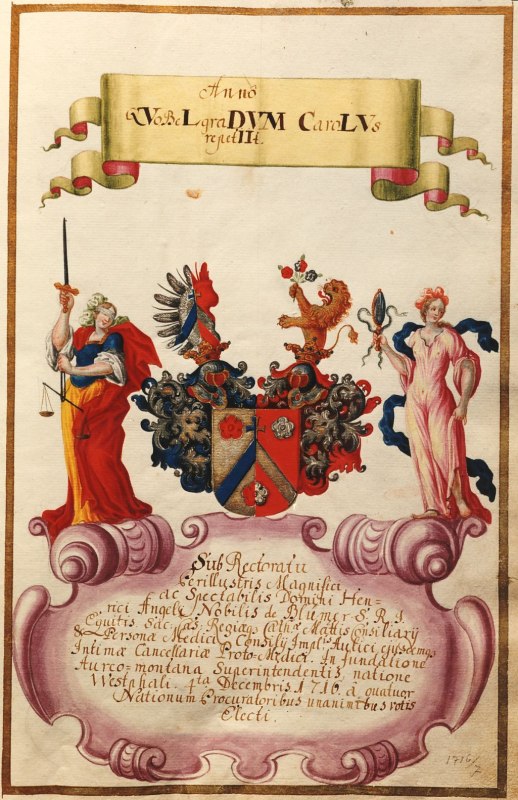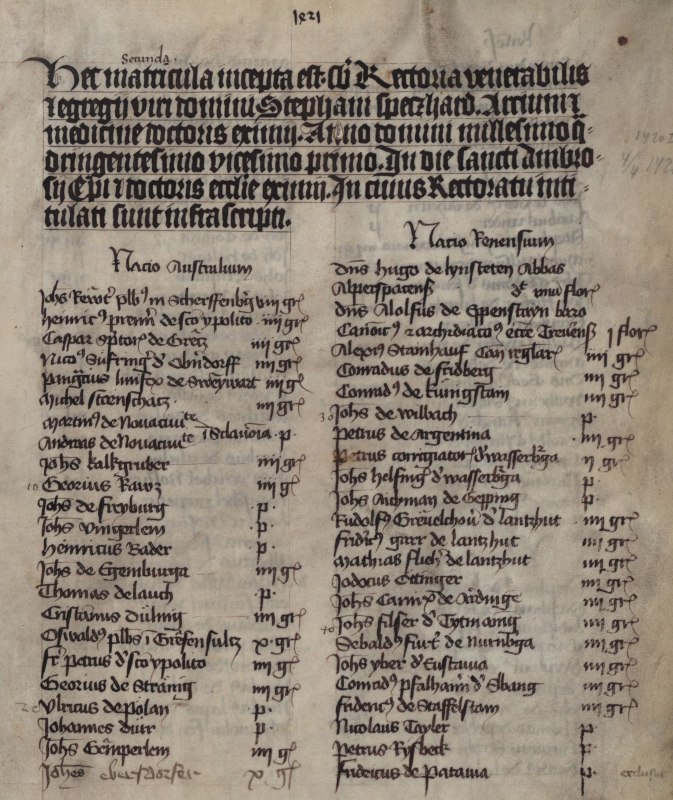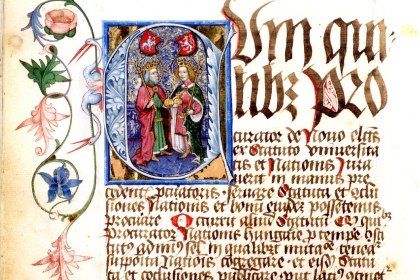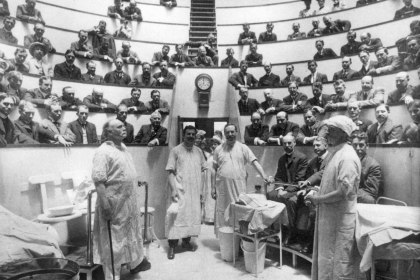Studying in the Middle Ages and in the Early Modern Age
“Male, honest, Christian” – this could be a short characterization of students at the medieval and early modern universities. What requirements did the universities’ statutes ask from new admissions and how were these norms handled in practice?
The admission to the university took place through matriculation. This was not a purely administrative act for the statistical recording of students, but was the foundation of a person’s membership in the university and the subjection to its jurisdiction. This is why the registers (Matrikel) included the names of the students, but also those of the teachers, other employees as well as of artisans who worked for the university outside of the regular guild laws. The registers also became continuously more sophisticated and representative.
In contrast to today’s education system, which demands the graduation from a secondary school or a university entrance exam for admission to a university, there were no such regulations in the medieval school system. There was no system of successive schools that built on one another, but a variety of monastery, parish or city schools coexisting with each other. The subjects taught in these schools ranged from elementary skills such as reading, writing and arithmetic, to disciplines also taught at universities. The standards mostly depended on the teacher’s knowledge and skills. Accordingly, there were almost no formal restrictions on admission of students to medieval universities.
Criteria for admission and expulsion
Most university statutes only demanded their candidates to be baptized, born in wedlock and having “moral conduct”. Proof for the first two points often only had to be presented at graduation. At some universities it was sufficient for the student to assert that he believed to have been born in wedlock.
These regulations meant that mainly non-Christians – Jews, and Muslims on the Iberian Peninsula – were excluded from studying. The de facto exclusion of women from universities actually had no judicial basis in the university statutes. Higher education of women was perhaps so inconceivable for the administration that they did not think to add clauses to this effect to the statutes.
Since the beginning of the Reformation the universities also demanded students to declare their affiliation to either the Catholic or Protestant denomination. At some universities, however, there were loopholes to avoid these restrictions: The Venetian government, for example, established special medical and law schools in the early 17th century, which also awarded academic titles to non-Catholics. The University of Padua protected its Protestant students from persecution by the Inquisition with an immunity privilege.
Other regulations, such as regional or social origin, or intellectual, linguistic or financial prerequisites were not addressed at admission. Since even the largest universities were still a long way from the mass universities of the 20th and 21st century, the contact between teachers and students was far more intimate. The teachers picked their students personally, taking their level of education into account, thus implementing a certain minimum standard. Nevertheless, there is evidence that students occasionally learnt the scientific language of Latin or even reading and writing at the university.
Admission into the “community of teachers and students” – the matriculation
When a student had been accepted by a teacher, he was entered into the register. With the development of university structures, these student lists evolved from records kept privately by each teacher to member registries of the faculties, academic nations and the whole university, usually called “Matrikel” (the terms album, rotulus or cedula were also sometimes used). The entry in the registries (most often kept by the rectorate) was the foundation of a person’s membership in the university and held high importance, since the universities possessed their own judicial system.
The legal act was usually divided into three parts: After the new arrival had petitioned the rector for matriculation, he paid a fee which depended on social status and financial possibilities. He then swore to uphold the university statutes, to obey the rector as the head of the university, to support the community to the best of his abilities and to not take revenge for injustices he might suffer. At the conclusion of this ceremony his name was entered into the register. This was usually done by the rector himself or – from the 16th century onward – by clerks. At some universities the students entered their names into the register themselves.
Because the matriculation was evidence of a person’s subjection to the university’s legal system, not only students were entered into the register, but also teachers, other university employees, such as professors’ servants or artisans working for the university, were recorded as well. The latter were also called “academic citizens”.
Design of the register – from functional manuscript to representational object
The registers are structured by rectors’ (or deans’ or bursars’) terms of office. In the rector’s register the entries after 1385 are sorted by membership in the four academic nations. A single matriculation ideally includes the date of enrollment (usually the semester, sometimes even the exact date), name and origin, as well as information on payment and amount of register fees or on the exemption from them. In some cases, details on the studied discipline and later course of life can also be found. This form of matriculation was maintained until the obligatory matriculation was abolished in 1784. When the matriculation was reintroduced in the early 19th century, the name and profession of the father or legal guardian was added as well.
This ideal was not always adhered to, however. Only since the middle of the 17th century consistent information on the studied discipline was recorded, while the data on paid register fees became increasingly sporadic from this time onwards. In the worst cases, the entry only included the name. If this concerned a person, who – as was not unusual in the Middle Ages – did not use a surname, it is almost impossible to find further biographical data.
The registers, at first unornamented functional manuscripts, became increasingly more elaborately designed from the end of the 17th century. The – often aristocratic – rectors had registers adorned with lavish, sometimes colored, decorative sheets with their crests or with allegoric illustrations. Reports on events or laws concerning the university as well as other notes on things such as marriages or deaths in the royal family, wars, plagues or the like, were entered into the register.
Exmatriculation as a disciplinary measure
Ideally, the membership in the academic community which had begun at the matriculation held a lifetime. University members could, however, be expelled from this community as well. Since the university membership was bound to privileges, temporary or permanent exmatriculations were used as disciplinary measures: The offender’s name was struck from the register. In some cases, the reasons for the expulsion were named. These ranged from offences against the university’s disciplinary regulations to criminal charges such as theft, forgery of documents, heresy, adultery or murder..
-

Rektorsblatt aus der Wiener Universitätsmatrikel
Rektorsblatt des Heinrich Angelus von Blümer (Rektor der Universität Wien 1716/17, gestorben 1732). Im oberen Teil ein Spruchband mit der Aufschrift...



